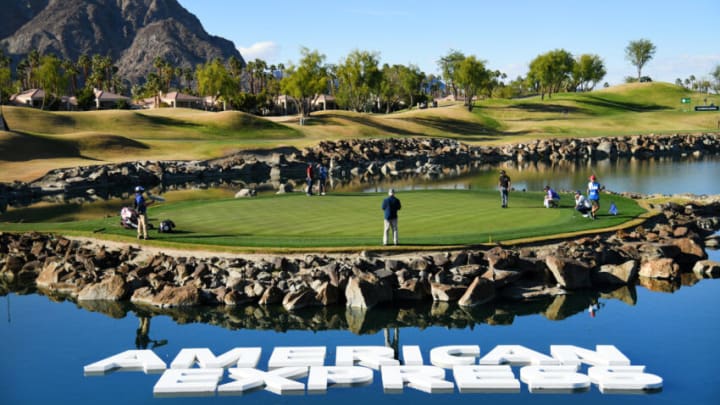Patrick Cantlay’s 61 at Last Year’s AmEx — Just How Good Was It?

“I saw the article that said that the guys came here and played in ’87, and it was so hard that they boycotted and said they would never come back,” Patrick Cantlay said at his pre-tournament press conference about the TPC Stadium Course at PGA West.
He’s right. It did happen. Cantlay was not quite five years old at the time. He was a couple months shy of his 24th birthday in 2016 when it was added back to what is now the American Express.
Patrick Cantlay finished second in 2021, and this week, he was asked about his low final-round score, a 61. It was good, but just not quite good enough.
“I thought last year when I finished, I would at least have a chance at a playoff,” he said. He doesn’t think the 61 he shot in the final round last year is a number that could have been shot when the course opened.
But there are some facts Patrick Cantlay, as good as he is, doesn’t know about the Stadium Course. A very low score was shot from the tips, 7700 yards, a couple of months before the course opened in 1986.
the reason the TPC Stadium Course was voted out was that it was so hard compared to the other courses in the rotation
First of all, the reason the TPC Stadium Course was voted out was that it was so hard compared to the other courses in the rotation, which were Indian Wells, Bermuda Dunes, Tamarisk, La Quinta CC, and Eldorado, with Tamarisk and Eldorado taking turns every other year. Golfers were afraid that they might get a windy day when playing the Stadium Course, and if that happened, it would put them at a disadvantage compared to the rest of the field on – honestly – easier tracks. They were right about that. Here’s what the comparison looked like.
In 1986, the courses for what was then the Bob Hope Chrysler Classic were Bermuda Dunes, the host course, at 6,837 yards; Eldorado CC, at 6,708 yards, Indian Wells at 6,478 yards and La Quinta CC at 6,911 yards. Donnie Hammond won in a playoff over John Cook.
Now, come 1987, the courses were PGA West, Stadium Course, the host, which they played at 7000 yards; Bermuda Dunes, at 6837 yards; Indian Wells, at 6478 yards and Tamarisk, at 6819 yards. (All this according to old PGA Tour media guides.)
Short-hitting Corey Pavin won, and not-very-long-hitting Bernhard Langer was second on what was considered a very long course at the time.
Last year, when Patrick Cantlay was second, PGA West Stadium Course was probably playing something similar to what it is this year, 7147 yards.
“I imagine when they built the place in ’87, or they must have built it before that, obviously, in the ’80s, but they could have never imagined me shooting 61 on the golf course because you just couldn’t do it,” he insisted. “That seems to me the biggest concern as far as distance and golf ball is, to keep a golf course relevant, the tees have to go back, back, back, all the time.”
The reason the course was made at what was then an ungodly length of 7700 yards is that Pete Dye anticipated what could happen with scoring in the future, at least as far as could be seen. Since he was provided with enough land and asked to create something at least as impossible to play as TPC Sawgrass, he made it long and very scary looking.
( I know this because I used to work for the owners who had the course built and talked about the scariness of it with Dye.)
As most golfers know, there’s 6500-6700 yards of mostly fairways and the occasional bunker on newly-built, average 1970s and early 1980s golf courses. Then there’s the kind of hazards at PGA West Stadium. A 19-foot deep (at least it was that size) bunker at the 16th hole. A near island green like the one at TPC Sawgrass for the 17th, but with big rocks around it. A sand moat nine or 10 feet deep around the green at the 12th. And at the time the unheard-of 255-yard par three 6th hole. Across water. (That was back when par threes were said to end at 255, and when par fives were said to start at 475, and everything in between was a par four.)
Prior to the PGA West Stadium course opening in January of 1986, Fred Couples, John Cook, and some other pros who lived in the desert at the time went out to give the course a test drive. It was November or December of 1985. Professional golfers still hit wooden drivers and balata balls. Playing from the tips, 7700 yards, Couples shot a 64 and beat everybody in the group. (I was told by executives in the company that owned the course, that Couples used a 3-wood on the 6th.)
Before holding tight to his theory that no one in the past could have shot a 61 at PGA West Stadium, maybe Patrick Cantlay needs to talk to his good pal Fred Couples.
Which is better? A 61 at 7147 yards with today’s high-tech drivers and balls that fly forever or a 64 from 7700 yards with a wooden driver and balata balls?
It would be interesting to hear them discuss it.